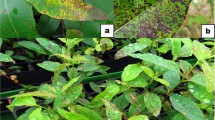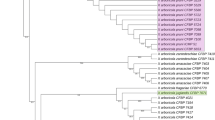Abstract
Strains of Xanthomonas campestris pv. vignicola (Xcv), isolated from cowpea leaves with blight or minute pustules and collected from various geographic areas, were selected on the basis of pathological and physiological features. All strains were analyzed for genotypic markers by two methods: ribotyping with EcoRI endonuclease, and RFLP analysis with a plasmid probe (pthB) containing a gene required for pathogenicity from Xanthomonas campestris pv. manihotis. Ribotyping revealed a unique pattern for all the strains that corresponded to the previously described ribotype rRNA7. Based on polymorphism detected by pthB among Xcv strains, nine haplotypes were defined. The observed genetic variation was independent of the geographic origin of the strains and of pathogenic variation. Some haplotypes were widely distributed, whereas others were localized. In some cases, we could differentiate strains isolated from blight symptoms and pustules according to haplotypic composition. However, in most cases, no significant differences were observed. Our results and the previous pathogenic and biochemical characterizations suggest that the strains isolated from leaves with blight symptoms or minute pustules belong to the same pathovar. We provide information on pathogen diversity that can be used to identify and characterize resistant germplasm.
Similar content being viewed by others
References
Adhikari TB, Cruz CMV, Zhang Q, Nelson RJ, Skinner DZ, Mew TW and Leach JE (1995) Genetic diversity of Xanthomonas oryzaepv. oryzaein Asia. Appl Environ Microbiol 61: 966-971
Alvarez AM, Benedict AA, Mizumoto CY, Hunter JE and Gabriel DW (1994) Serological, pathological, and genetic diversity among strains of Xanthomonas campestrisinfecting crucifers. Phytopathology 84: 1449-1457
Ardales EY, Leung H, Vera Cruz CM, Mew TW, Leach JE and Nelson RJ (1996) Hierarchical analysis of spatial variation of the rice bacterial blight pathogen across diverse agroecosystems in the Philippines. Phytopathology 86: 241-252
Ausubel, FM, Brent R, Kingston RE, Moore DD, Seidman JG, Smith JA and Struhl K (1992) Current protocols in molecular biology. Greene Publishing Associates-Wiley Interscience, New York, NY
Bashir M and Haptom RO (1996) Sources of genetic resistance in cowpea (Vigna unguiculataL. Walp.) to cowpea aphid-borne mosaic potyvirus. Eur J Plant Pathol 102: 411-419
Berthier Y, Verdier V, Guesdon JL, Chevrier D, Denis JB, Decoux G and Lemattre M(1993) Characterization of Xanthomonas campestrispathovars by rRNA gene restriction patterns. Appl Environ Microbiol 59: 851-859
Bragard C, Verdier V and Maraite H (1995) Genetic diversity among Xanthomonas campestrisstrains pathogenic for small grains. Appl Environ Microbiol 61: 1020-1026
De Feyter R and Gabriel DW (1991) At least six avirulence genes are clustered on a 90-kilobase plasmid in Xanthomonas campestrispv. malvacearum .Mol Plant-Microbe Interact 4: 423-432
De Feyter R, Yang Y and Gabriel DW (1993) Gene-for-genes interactions between cotton R genes and Xanthomonas campestrispv. malvacearum avrgenes. Mol Plant-Microbe Interact 6: 225-237
Gagnevin L, Leach JE and Pruvost O (1997) Genomic variability of the Xanthomonaspathovar mangiferaeindicae, agent of mango bacterial black spot. Appl Environ Microbiol 63: 246-253
Gitaitis RD (1982) Resistance in cowpea to bacterial blight and canker. Phytopathology 72: 999
Gitaitis RD (1983) Two resistant responses in cowpea induced by different strains of Xanthomonas campestrispv. vignicola. Plant Dis 67: 1025-1028
Gitaitis RD and Nilakhe SS (1982) Detection of Xanthomonas campestrispv. vignicolain southern pea seed. Plant Dis 66: 20-22
Gitatis RD, Bell DK and Smittle DA (1986) Epidemiology and control of bacterial blight and canker of cowpea. Plant Dis 70: 187-190
Grimont F and Grimont PAD (1986) Ribosomal ribonucleic acid gene restriction patterns as potential taxonomic tools. Ann Inst Pasteur Microbiol 137B: 165-175
Jindal JK and Patel PN (1984) Variability in xanthomonads of grain legumes. IV. Variations in bacteriological properties of 83 strains and pathogenic behavior of cultural variants. Phytopathol Z 110: 63-68
Kaiser WJ and NG Vakili (1978) Insect transmission of pathogenic xanthomonads to bean and cowpea in Puerto Rico. Phytopathology 68: 1057-1063.
Khatri-Chhetri G, Wydra K and Rudolph K (1995) Pathological and physiological characterization of the incitant of cowpea bacterial blight and bacterial pustule, Xanthomonas campestrispv. vignicola,from different geographic origins. World Cowpea Research Conference II, Accra, Ghana, 3-9 September 1995. Abstract
Khatri-Chhetri G, Wydra K and Rudolph K (1996a) Analysis of virulence and metabolic fingerprints of Xanthomonas campestrispv. vignicolastrains causing bacterial blight and bacterial pustule on cowpea in different geographic areas. Mitt. Biolog. Bundesanstalt und Forstwirtschaft, H. 321: 641-642
Khatri-Chhetri G, Wydra K and Rudolph K (1996b) Variability of strains of Xanthomonas campestrispv. vignicola,incitant of cowpea bacterial blight and bacterial pustule, collected in several African and other countries. In Proceedings of the IX Int Conf Plant Pathol Bacteria, Madras, India, in press
Kishun R (1989) Appraisal of loss in yield of cowpea due to Xanthomonas campestrispv. vignicola .Indian Phytopathol 42: 241-246
Leach JE and White FF (1996) Bacterial avirulence genes. Annu. Rev. Phytopathol. 34: 153-179
Leach JE, White FF, Rhoads ML and Leung H (1990) A repetitive DNA sequence differentiates Xanthomonas campestrispv. oryzae from other pathovars of X. campestris. Mol Plant Microbe Interact 3: 238-246
Leach JE, Rhoads ML, Vera Cruz CM, White FF, Mew TW and Leung H (1992) Assessment of genetic diversity and population structure of Xanthomonas oryzaepv. oryzaewith a repetitive DNA element. Appl Environ Microbiol 58: 2188-2195
Louws FJ, Fulbright DW, Stephens CT and De Bruijn FJ (1994) Specific genomic fingerprints of phytopathogenic Xanthomonasand Pseudomonaspathovars and strains generated with repetitive sequences and PCR. Appl Environ Microbiol 60: 2286-2295
Louws FJ, Fulbright DW, Stephens, CT and de Bruijn FJ (1995) Differentiation of genomic structure by rep-PCR fingerprinting to rapidly classify Xanthomonas campestrispv. vesicatoria. Phytopathology 85: 528-536
Nassar A, Bertheau Y, Dervin C, Narcy JP and Lemattre M (1994) Ribotyping of Erwinia chrysanthemistrains in relation to their pathogenic and geographic distribution. Appl Environ Microbiol 60: 3781-3789
Nelson RJ, Baraoidan MR, Vera Cruz CM, Yap IV, Leach JE, Mew TW and Leung H (1994) Relationship between phylogeny and pathotype for the bacterial blight pathogen of rice. Appl Environ Microbiol 60: 3275-3283
Nesme X, Vaneechoutte M, Orso S, Hoste B and Swings J (1995) Diversity and genetic relatedness within genera Xanthomonasand Stenotrophomonasusing restriction endonuclease site differences of PCR-amplified 16S rRNA gene. Syst Appl Microbiol 18: 127-135
Patel PN (1983) Resistance to bacterial blight in cowpea in Tanzania and other countries. Indian J Genet 43: 2-12
Patel PN and Jindal JK (1982) Distinguishing reactions to the bacterial blight and pustule organisms of cowpea in pods of Phaseolus vulgaris.Z Pflanzenkrankh Pflanzensch 89, 406-409
Swarup S, Yang Y, Kingsley M and Gabriel D (1992) An Xanthomonas citripathogenicity gene, pthA, pleitropically encodes gratuitous avirulence on non hosts. Mol Plant-Microbe Interact 5: 204-213
Vauterin L, Hoste B, Kersters K and Swings J (1995) Reclassification of Xanthomonas.Int J Syst Bacteriol 45: 472-489
Vera Cruz CM, Ardales E, Skinner RJ, Talag J, Nelson RJ, Louws FJ, Leung H, Mew TW and Leach JE (1996) Measurement of haplotypic variation in Xanthomonas oryzaepv. oryzaewithin a single field by rep-PCR and RFLP analyses. Phytopathology 86: 1352-1359
Verdier V, Dongo P and Boher B (1993) Assessment of genetic diversity among strains of Xanthomonas campestrispv. manihotis. J Gen Microbiol 139: 2591-2601
Verdier V, Boher B, Maraite H and Geiger JP (1994) Pathological and molecular characterization of Xanthomonas campestrisstrains causing diseases of cassava (Manihot esculenta). Appl Environ Microbiol 60: 4478-4486
Verdier V, Cuny G, Assigbétsé K, Geiger JP and Boucher C (1996) Characterization of pathogenicity gene pthB in Xanthomonas campestrispv. manihotis. In: Stacey G, Mullin B and Gresshoff P (eds) abstracts of the 8th International Congress on Plant Microbe Interactions, 14-19 July, University of Tennessee, Knoxville, USA
Yang Y, De Feyter R and Gabriel DW (1994) Host-specific symptoms and increased release of Xanthomonas citriand X. campestrispv. malavacearumfrom leaves are determined by the 102-bp tandem repeats of pthA and avrb6 respectively. Mol Plant-Microbe Interact 7: 345-355
Yashitola J, Krishnaveni D, Reddy APK and Sonti RV (1997) Genetic diversity within the population of Xanthomonas oryzaepv. oryzaein India. Phytopathology 87: 760-7765
Author information
Authors and Affiliations
Rights and permissions
About this article
Cite this article
Verdier, V., Assigbétsé, K., Khatri-Chhetri, G. et al. Molecular characterization of the incitant of cowpea bacterial blight and pustule, Xanthomonas campestris pv. vignicola. European Journal of Plant Pathology 104, 595–602 (1998). https://doi.org/10.1023/A:1008610517437
Issue Date:
DOI: https://doi.org/10.1023/A:1008610517437




